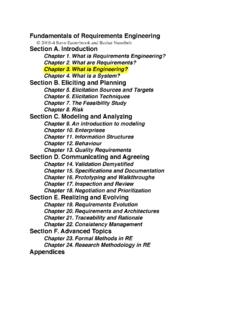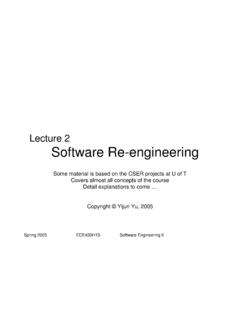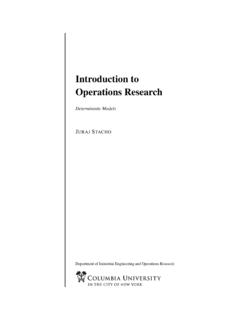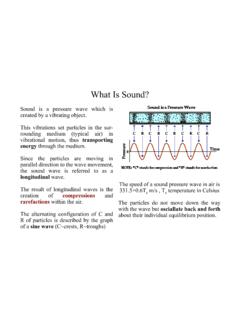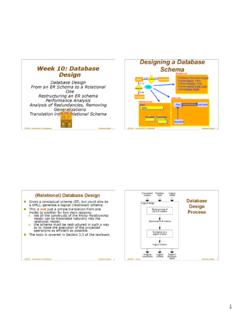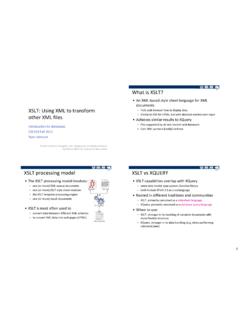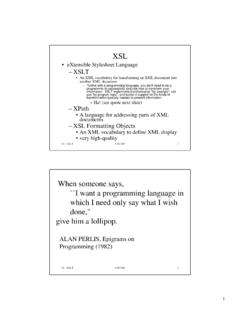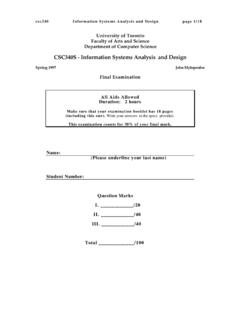Transcription of A Practical Guide to Training Restricted Boltzmann Machines
1 Department of Computer Science6 King s College Rd, TorontoUniversity of TorontoM5S 3G4, : +1 416 978 1455 Copyrightc Geoffrey Hinton 2, 2010 UTML TR 2010 003A Practical Guide to TrainingRestricted Boltzmann MachinesVersion 1 Geoffrey HintonDepartment of Computer Science, University of TorontoA Practical Guide to Training Restricted BoltzmannMachinesVersion 1 Geoffrey HintonDepartment of Computer Science, University of TorontoContents1 Introduction32 An overview of Restricted Boltzmann Machines and Contrastive Divergence33 How to collect statistics when using Contrastive Updating the hidden states .. Updating the visible states .. Collecting the statistics needed for learning .. A recipe for getting the learning signal for CD1..64 The size of a A recipe for dividing the Training set into mini-batches.
2 75 Monitoring the progress of A recipe for using the reconstruction error ..76 Monitoring the A recipe for monitoring the overfitting ..87 The learning A recipe for setting the learning rates for weights and biases ..88 The initial values of the weights and A recipe for setting the initial values of the weights and biases ..99 A recipe for using momentum .. 1010 A recipe for using weight-decay .. 1111 Encouraging sparse hidden A recipe for sparsity .. 1212 The number of hidden A recipe for choosing the number of hidden units .. 1213 Different types of Softmax and multinomial units .. Gaussian visible units .. Gaussian visible and hidden units .. Binomial units .. Rectified linear units .. 1414 Varieties of contrastive divergence1515 Displaying what is happening during learning1616 Using RBM s for Computing the free energy of a visible vector.
3 1717 Dealing with missing values1711If you make use of this technical report to train an RBM, please cite it in any resulting IntroductionRestricted Boltzmann Machines (RBMs) have been used as generative models of many differenttypes of data including labeled or unlabeled images (Hinton et al., 2006a), windows of mel-cepstralcoefficients that represent speech (Mohamed et al., 2009), bags of words that represent documents(Salakhutdinov and Hinton, 2009), and user ratings of movies (Salakhutdinov et al., 2007). In theirconditional form they can be used to model high-dimensional temporal sequences such as video ormotion capture data (Taylor et al., 2006) or speech (Mohamed and Hinton, 2010). Their mostimportant use is as learning modules that are composed to form deep belief nets (Hinton et al.)
4 ,2006a).RBMs are usually trained using the contrastive divergence learning procedure (Hinton, 2002).This requires a certain amount of Practical experience to decide how to set the values of numericalmeta-parameters such as the learning rate, the momentum, the weight-cost, the sparsity target, theinitial values of the weights, the number of hidden units and the size of each mini-batch. There are alsodecisions to be made about what types of units to use, whether to update their states stochasticallyor deterministically, how many times to update the states of the hidden units for each Training case,and whether to start each sequence of state updates at a data-vector. In addition, it is useful to knowhow to monitor the progress of learning and when to terminate the any particular application, the code that was used gives a complete specification of all ofthese decisions, but it does not explain why the decisions were made or how minor changes will affectperformance.
5 More significantly, it does not provide a novice user with any guidance about how tomake good decisions for a new application. This requires some sensible heuristics and the ability torelate failures of the learning to the decisions that caused those the last few years, the machine learning group at the University of Toronto has acquiredconsiderable expertise at Training RBMs and this Guide is an attempt to share this expertise withother machine learning researchers. We are still on a fairly steep part of the learning curve, so theguide is a living document that will be updated from time to time and the version number shouldalways be used when referring to An overview of Restricted Boltzmann Machines and ContrastiveDivergenceSkip this section if you already know about RBMsConsider a Training set of binary vectors which we will assume are binary images for the purposesof explanation.
6 The Training set can be modeled using a two-layer network called a RestrictedBoltzmann Machine (Smolensky, 1986; Freund and Haussler, 1992; Hinton, 2002) in which stochastic,binary pixels are connected to stochastic, binary feature detectors using symmetrically weightedconnections. The pixels correspond to visible units of the RBM because their states are observed;the feature detectors correspond to hidden units. A joint configuration, (v,h) of the visible andhidden units has an energy (Hopfield, 1982) given by:E(v,h) = i visibleaivi j hiddenbjhj i,jvihjwij(1)wherevi,hjare the binary states of visible unitiand hidden unitj,ai,bjare their biases andwijisthe weight between them. The network assigns a probability to every possible pair of a visible and a3hidden vector via this energy function:p(v,h) =1Ze E(v,h)(2)where the partition function ,Z, is given by summing over all possible pairs of visible and hiddenvectors:Z= v,he E(v,h)(3)The probability that the network assigns to a visible vector,v, is given by summing over all possiblehidden vectors:p(v) =1Z he E(v,h)(4)The probability that the network assigns to a Training image can be raised by adjusting the weightsand biases to lower the energy of that image and to raise the energy of other images, especially thosethat have low energies and therefore make a big contribution to the partition function.
7 The derivativeof the log probability of a Training vector with respect to a weight is surprisingly simple. logp(v) wij= vihj data vihj model(5)where the angle brackets are used to denote expectations under the distribution specified by thesubscript that follows. This leads to a very simple learning rule for performing stochastic steepestascent in the log probability of the Training data: wij= ( vihj data vihj model)(6)where is a learning there are no direct connections between hidden units in an RBM, it is very easy to getan unbiased sample of vihj data. Given a randomly selected Training image,v, the binary state,hj,of each hidden unit,j, is set to 1 with probabilityp(hj= 1|v) = (bj+ iviwij)(7)where (x) is the logistic sigmoid function 1/(1 + exp( x)).vihjis then an unbiased there are no direct connections between visible units in an RBM, it is also very easy toget an unbiased sample of the state of a visible unit,given a hidden vectorp(vi= 1|h) = (ai+ jhjwij)(8)Getting an unbiased sample of vihj model, however, is much more difficult.
8 It can be done bystarting at any random state of the visible units and performing alternating Gibbs sampling for a verylong time. One iteration of alternating Gibbs sampling consists of updating all of the hidden unitsin parallel using equation 7 followed by updating all of the visible units in parallel using equation much faster learning procedure was proposed in Hinton (2002). This starts by setting thestates of the visible units to a Training vector. Then the binary states of the hidden units are allcomputed in parallel using equation 7. Once binary states have been chosen for the hidden units,4a reconstruction is produced by setting eachvito 1 with a probability given by equation 8. Thechange in a weight is then given by wij= ( vihj data vihj recon)(9)A simplified version of the same learning rule that uses the states of indivisdual units instead ofpairwise products is used for the learning works well even though it is only crudely approximating the gradient of the log prob-ability of the Training data (Hinton, 2002).
9 The learning rule is much more closely approximating thegradient of another objective function called the Contrastive Divergence (Hinton, 2002) which is thedifference between two Kullback-Liebler divergences, but it ignores one tricky term in this objectivefunction so it is not even following that gradient. Indeed, Sutskever and Tieleman have shown that itis not following the gradient of any function (Sutskever and Tieleman, 2010). Nevertheless, it workswell enough to achieve success in many significant typically learn better models if more steps of alternating Gibbs sampling are used beforecollecting the statistics for the second term in the learning rule, which will be called the negativestatistics. CDnwill be used to denote learning usingnfull steps of alternating Gibbs How to collect statistics when using Contrastive DivergenceTo begin with, we shall assume that all of the visible and hidden units are binary.
10 Other types ofunits will be discussed in sections 13. We shall also assume that the purpose of the learning is tocreate a good generative model of the set of Training vectors. When using RBMs to learn Deep BeliefNets (see the article on Deep Belief Networks at ) that will subsequently befine-tuned using backpropagation, the generative model is not the ultimate objective and it may bepossible to save time by underfitting it, but we will ignore that Updating the hidden statesAssuming that the hidden units are binary and that you are using CD1, the hidden units should havestochastic binary states when they are being driven by a data-vector. The probability of turning ona hidden unit,j, is computed by applying the logistic function (x) = 1/(1 + exp( x)) to its totalinput :p(hj= 1) = (bj+ iviwij)(10)and the hidden unit turns on if this probability is greater than a random number uniformly distributedbetween 0 and is very important to make these hidden states binary, rather than using the probabilitiesthemselves.
